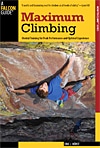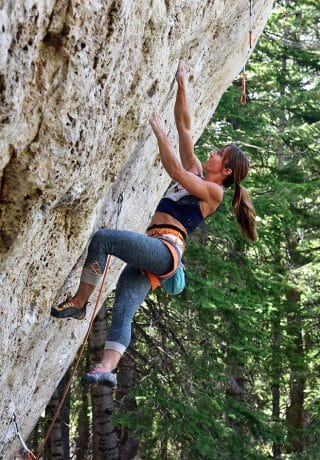Leveraging “Process Feedback” to Elevate Performance
Obtaining a high level of performance in any endeavor—and ultimately reaching your goals—depends on your ability to recognize and leverage ongoing process feedback and results. Process feedback involves subtle proprioceptive and exteroceptive cues that constantly change moment by moment. As a climbing example, you might shift your center of gravity toward a high foot placement and become aware of a growing loss of balance and increasing difficulty in gripping a slopping hold. Based on this proprioceptive feedback, you twist your body and position your inside hip closer to the wall; the result is improved stability, balance, and grip on the rock.
Process feedback, as in the example above, arises in a broad stream from all of your muscles and joints throughout every move of every climb. Yet for many climbers, self-awareness of these vital data is quite low, as only the screaming proprioceptive messages (for example, I feel my foot slipping or I’m about to fall!) register in their conscious mind. Elite climbers, however, possess acute awareness of process feedback and they can tap into proprioceptive sensations in an instant to optimize a foot placement, body position, or movement. Gaining such a high level of self-awareness of process feedback comes only by way of a long-term, conscious effort to tap into the subtle physical sensations that constantly spring forth as you climb. Be patient and take the time to develop this critical ability!
On the macro scale, you must also strive to recognize the gross results feedback that provides clues on the effectiveness of your actions and chosen strategy. On the surface such results feedback seems to be simply an outcome of an action taken—for example, falling off a given move or failing on a route. Awareness of these results takes little effort—the message is obvious, right? Well, not really; there’s always a deeper message to be found if you possess the self-awareness to look for it.
Making the most of results feedback demands that you search back for the cause of the poor outcome. For example, you might ask yourself: Is my limiting constraint mental, technical, or physical in nature? As always, you can sharpen self-awareness by asking a series of probing questions: Was I climbing too slowly? Is there a better sequence to be found? Is fear preventing me from fully committing to the moves? Obviously there are countless other questions you could ask, so keep an open mind and play the role of a performance detective who’s trying to uncover clues for success.
Keep an open mind and play the role of a performance detective who’s trying to uncover clues for success.
Another strategy to improve self-awareness of results is to view yourself climbing or training from an observer’s perspective, as if watching yourself on TV. In your mind’s eye, examine the strategies you have employed, the ways you’ve been training, and your overall behavior at the crags and elsewhere. From this disassociated perspective you can be more critical in your assessment, usually without the undesirable side effect of getting yourself down. Can you identify a flawed strategy? Are the same actions being taken over and over without any course corrections? Are training practices ineffective, perhaps failing to address known weaknesses? Do you see emotions getting out of hand and adversely affecting performance?
This latter idea of emotions getting out of hand and clouding self-awareness is critical. Too much emotion of any kind—even overconfidence—not only overwhelms subtle proprioceptive feedback but can also cause you to miss the more blatant results feedback that provides the clues to correct your course and eventually reach your goals. Similarly, ego diminishes self-awareness—in fact they tend to be mutually exclusive. It should be no surprise, then, the very best climbers most often exhibit a humble, quiet demeanor that enables them to remain curious, introspective, and highly self-aware.
 Did you find this article helpful? If so, there’s a book loaded with practical and effective mental tips and tricks—it’s called Maximum Climbing: Mental Training for Peak Performance and Optimal Experience.
Did you find this article helpful? If so, there’s a book loaded with practical and effective mental tips and tricks—it’s called Maximum Climbing: Mental Training for Peak Performance and Optimal Experience.
Achieving the next grade or doing the ‘impossible’ is a battle fought more in the mind than in the body.
In Maximum Climbing, Eric Hörst presents a climber’s guide to the software of the brain—one that will prove invaluable whether your preference is bouldering, sport climbing, traditional climbing, or mountaineering. Maximum Climbing is thus a content-rich text with enormous information flow, and it has the astonishing potential to change and serve you in new ways as you change in the years to come. Eric brings unprecedented clarity to the many cognitive and neurophysical aspects of climbing and dovetails this information into a complete program. By learning and steadfastly applying these techniques, you will come to perform and achieve—in climbing and beyond—at a level that you can hardly imagine today! Learn more about Maximum Climbing >>
Copyright © 2017 Eric J. Hörst


